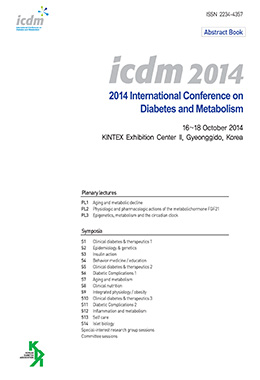Objective: Nonalcoholic fatty liver disease (NAFLD) has recently been defined as the hepatic expression of metabolic syndrome. Both visceral obesity (VO) and NAFLD play important roles in developing insulin resistance (IR). The aim of this study was to investigate differences in clinical and metabolic characteristics according to VO and/or NAFLD in Korean subjects with type 2 diabetes mellitus (DM).
Methods: A total of 2,598 (male 1,196 and female 1,402) DM subjects who visited our clinic from 2003 to 2012 were enrolled. We divided each gender into three groups as follows: control, only VO, and VO with NAFLD groups. Insulin sensitivity was assessed by the rate constant of plasma glucose disappearance (Kitt %/min) using a short insulin tolerance test; IR was defined as Kitt of less than 2.5. And visceral fat thickness (VFT) and fatty changes of liver were examined by ultrasonography.
Results: The prevalence of diabetic subjects who had VO and NAFLD (30.8% in male and 46.6% in female, respectively) was higher than that of those who had only VO. In addition, waist circumference and VFT were increased in the following order: control, only VO, and VO with NAFLD groups. IR was significantly higher in subjects who had VO than the control group, and most prominently in the VO with NAFLD group. In female subjects, most of the lipid profiles and HbA1c levels in the NAFLD combined group were definitely higher compared to the other two groups, but part of these differences diminished in male. Moreover, there was significant difference in the odds ratio (OR) for IR between control and only VO or VO with NAFLD groups (1.139 vs. 2.930 in male, and 1.826 vs. 3.509 in female, respectively).
Conclusion: These findings indicate that DM subjects who show VO and NAFLD can have more adverse effects on their metabolic parameters than those who show only VO.




